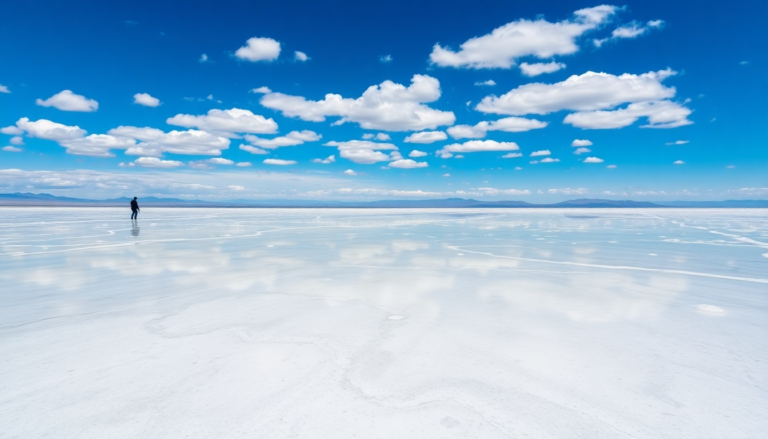Argomenti trattati
Imagine standing on an endless expanse of white, where the horizon disappears into the sky. Welcome to Salar de Uyuni in Bolivia, the world’s largest salt flat, a breathtaking natural wonder that feels like stepping onto another planet. This surreal landscape, especially when covered by a thin layer of water, transforms into a giant mirror, reflecting the clouds above and creating an otherworldly experience for visitors. But getting there is just the beginning of an incredible adventure.
Understanding the magnificence of Salar de Uyuni
Nestled in the Altiplano region of Bolivia, Salar de Uyuni stretches over 10,500 square kilometers at an altitude of about 3,600 meters. It’s not just a breathtaking sight; it also holds an estimated 7% of the world’s known lithium reserves beneath its crust, which is a hot topic in today’s tech-driven world. The sheer scale of the salt flat is astonishing. Standing there, it’s hard to grasp the enormity of it all, almost as if time and space have ceased to exist. This vast expanse of salt, which can be seen from space, is made up of over 10 billion tons of salt, enough to make anyone feel minuscule in comparison.
But what truly captivates are the changing vistas; during the rainy season from December to March, a thin layer of water transforms the flat into a stunning reflective surface. I remember my first glimpse of this phenomenon—it felt like I was floating in a dream, surrounded by the sky. The experience is both humbling and exhilarating, as you realize how small you are in the grand scheme of nature.
Getting there and what to expect
Reaching Salar de Uyuni is an adventure in itself. Located near the border with Chile and Argentina, travelers typically start their journey in La Paz. The drive can be long, but it’s a chance to soak in the unique landscapes and local culture along the way. Tours vary in duration, lasting anywhere from a day to several days, and they provide a fantastic way to explore the salt flat and surrounding areas.
Pack your warm clothes—daytime temperatures can be quite pleasant, but as night falls, it can plummet to -15 degrees Celsius. It’s a stark reminder of the high altitude you’re in, and acclimatizing is essential to avoid altitude sickness. I recall a friend who disregarded this advice and ended up feeling unwell, missing out on some stunning views.
Exploring the highlights
There’s so much more to discover beyond the salt flat itself. The journey often begins at the Train Graveyard near Uyuni, an eerie yet fascinating site filled with abandoned locomotives that tell tales of the region’s railway history. Moving on, you can visit the village of Colchani, famous for its salt processing, where you can learn about how salt is harvested and perhaps pick up a few unique souvenirs.
One cannot miss Isla Incahuasi, a rocky outcrop adorned with giant cacti that rise majestically from the salt crust. Standing there, surrounded by towering cacti with the vast white plain stretching out beneath you, is a sight that will be etched in your memory forever. And if you’re lucky enough to visit during the rainy season, the views are nothing short of spectacular.
The magical lagoons
As you venture further, you’ll encounter several stunning lagoons, each with its character. Laguna Hedionda, for instance, is a salty lake where flamingos wade gracefully, their pink feathers contrasting against the white backdrop. Nearby, Laguna Verde dazzles with its emerald waters, while Laguna Blanca offers a serene escape with its calm, white-tinted waves.
Then, there’s Laguna Colorada, known for its striking red hue, particularly stunning at sunrise. These lagoons are not just beautiful; they are teeming with life, providing habitats for a variety of bird species. The combination of colors and the backdrop of mountains creates a breathtaking landscape that feels like something out of a fantasy novel.
Geothermal wonders and legends
But the wonders of this region don’t stop at the lagoons. The geothermal field of Sol de Mañana features bubbling geysers and steaming mud pools, presenting a stark contrast to the serene beauty of the salt flats. Standing there, I felt like I was watching the Earth breathe, releasing its inner heat in dramatic bursts. And let’s not forget the hot springs—taking a dip in the natural thermal baths at Polque is a rejuvenating experience, especially after a long day exploring.
As with many magical places, Salar de Uyuni is steeped in legends. One tale speaks of the giant Tunupa, who shed tears that turned into salt, creating the flat we see today. These stories add a layer of mystique to the already enchanting landscape, inviting curiosity and imagination.
A journey of a lifetime
In conclusion, a visit to Salar de Uyuni is more than just a trip; it’s an immersion into a breathtaking natural wonder that transforms with the seasons. Whether you’re captivated by its vastness, intrigued by its geological features, or enchanted by the rich tapestry of local culture and lore, this destination offers something for every traveler. It’s a place that lingers in your memory, reminding you of the beauty and power of nature. Traveling through this surreal landscape is an adventure that stays with you long after you leave—one that beckons you to return.

